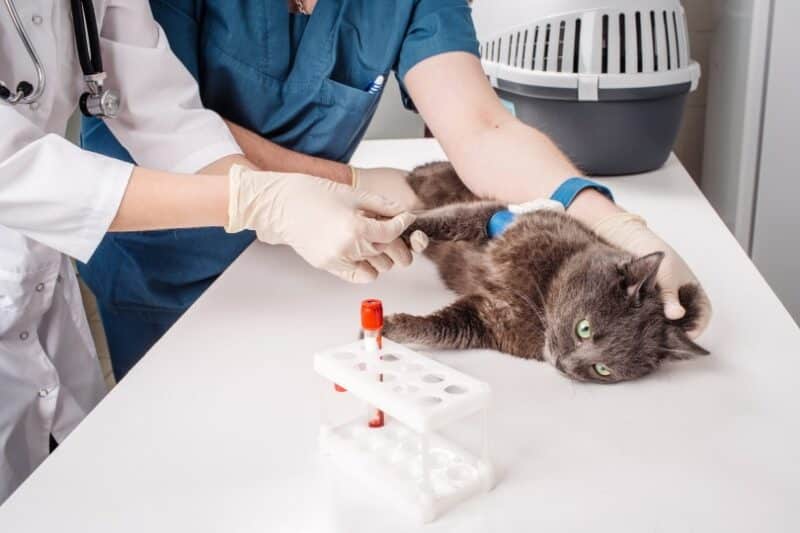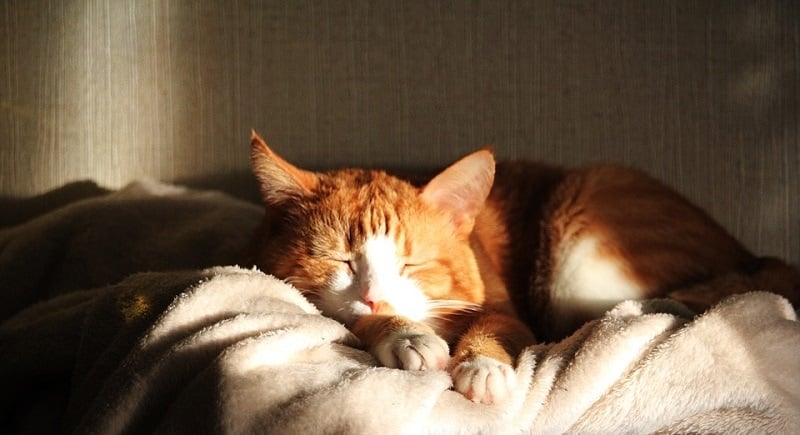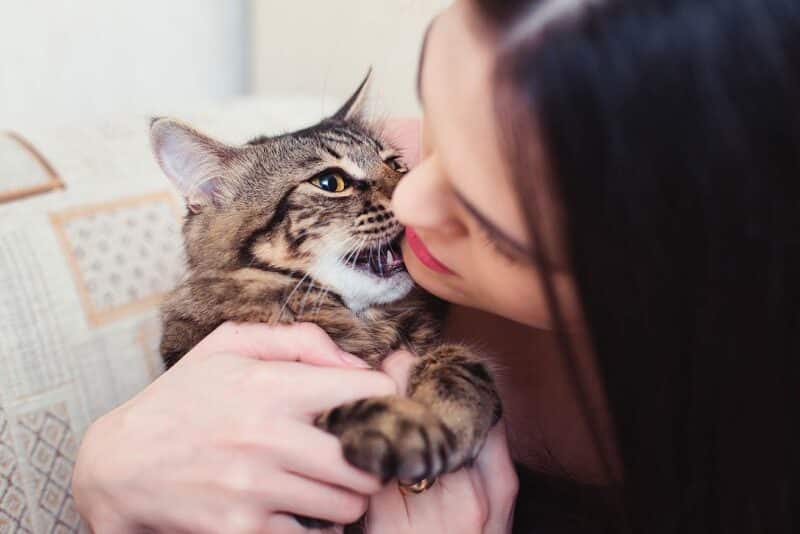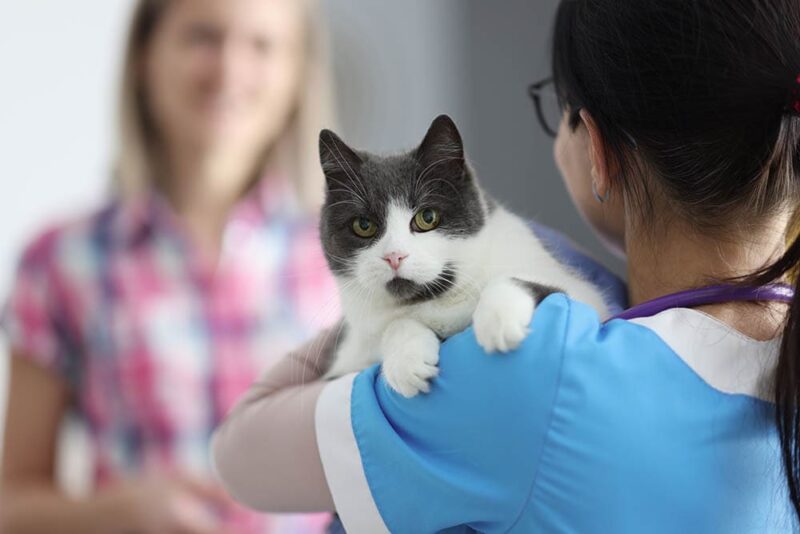In this article
Whether your cat is displaying signs of allergies or you just want to get ahead of things, you might wonder how exactly allergy testing works. After all, it can sometimes be lengthy and very much trial and error.
Here, we will discuss the different kinds of allergy testing and how veterinarians and veterinary dermatologists determine the allergy trigger. Keep in mind that this is in no way a substitution for medical advice, and you should always seek a vet’s attention if you suspect allergies in your cat.

How Does It Work?
Allergies are common in felines and can stem from numerous sources. Your cat could be allergic to something in their environment or diet. If a vet suspects your cat might have allergies, they will recommend a method of allergy testing.
Before allergy testing is performed, the vet will first rule out other common causes for itchy skin disease or gastrointestinal signs before suspecting an underlying allergy. Some types of allergies, such as atopic dermatitis, are sometimes a diagnosis of exclusion, as there is no available definitive test. Allergy testing typically involves a diet trial, injecting allergens into the skin by a veterinary dermatologist, or taking a blood sample to analyze it further.
Usually, the process is relatively fast, causing minimal discomfort to your pet, while food trials usually last at least 8 weeks. Once a vet determines the underlying cause of the allergy, they will recommend a treatment plan to address it appropriately.
Many cats will suffer from other common causes of skin disease, such as flea infestation, bacterial or fungal infection, and underlying systemic or auto-immune disease, and it’s important for the vet to rule these out before starting the next step in the diagnostic process, which involves allergy testing.

What Are the Different Types of Allergy Tests for Cats?
Food trials are used as a way of ruling out or identifying certain food proteins your cat may be allergic to. A vet will recommend it when it comes to suspected food allergies, although they are not considered a genuine test. A food trial requires that your cat eats a special diet for at least 8 weeks without any other treats or ingredients. This diet is usually based on a novel protein your cat has never eaten before, or on a veterinary hydrolyzed diet that is made in a way that the protein is broken down into small molecules that are then unable to trigger the cat’s immune system.
However, we will focus on the two types of allergy tests that are performed by the vet and a veterinary dermatologist at the clinic. Allergy testing in cats uses two techniques, which are intradermal skin testing and RAST testing. Each method has its pros and cons, so it will greatly depend on the individual cat and the suspected underlying cause of allergies. Veterinary dermatologists may combine both tests in order to receive the most accurate and reliable results.
Intradermal Skin Testing
Many vets revere intradermal skin testing as the gold standard for determining the cause of atopic dermatitis. Veterinary dermatologists are the only ones qualified to perform this test, so it’s a specialized field.
Even though this test is incredibly accurate, it’s not available to all pet parents. A vet will likely have to refer you to a specialist. Not only can testing be much more expensive this way, but it can also take a lot of work to get in for an appointment.
Intradermal testing is typically used to uncover environmental allergies with triggers like pollen, grasses, molds, house dust mites, and other irritants, as well as fleas in the case of a flea saliva allergy. The veterinary dermatologist will inject a very small amount of different allergens (from 40-80, depending on the kit) beneath the skin, in the subcutaneous layer.
Before the injection, cats are given a sedative, as the test can be somewhat uncomfortable.
It takes roughly 20-30 minutes for intradermal testing reactions to become apparent from the time of injection, but sometimes, some of the results can be read even after 24 hours. If a bump or hive forms where the allergen was injected, it’s compared to the positive and negative control before establishing the final result. A vet will devise a plan for treatment after the results are determined.
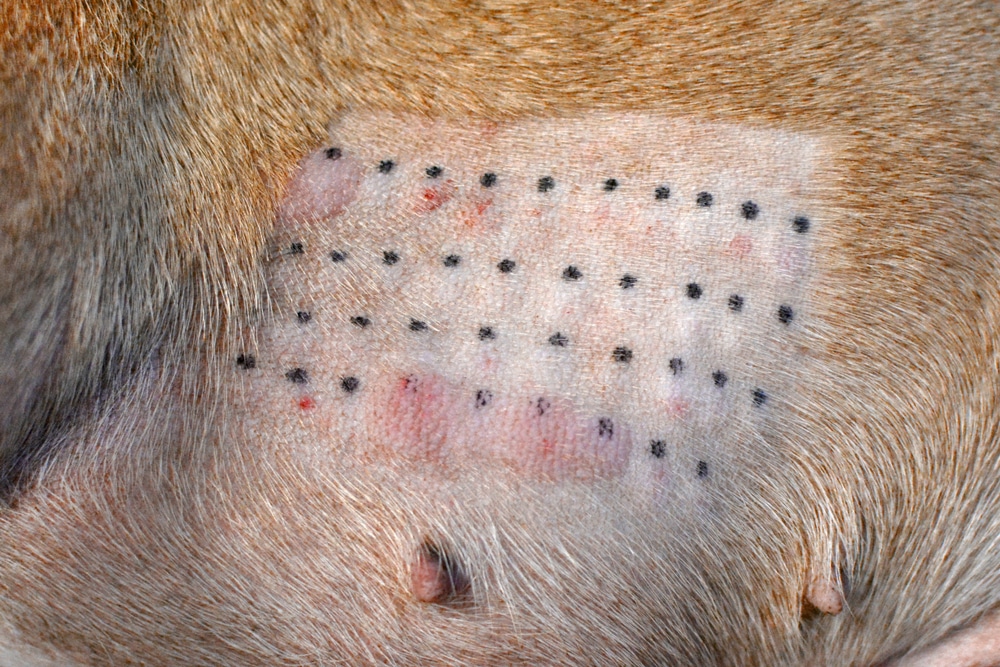
Radioallergosorbent Testing (RAST)
RAST Testing requires a single blood sample and can be drawn by a veterinarian during a routine visit. Many prefer this testing because you don’t need a specialized doctor.
RAST is a fairly quick serological test, but it has its limitations and is not considered as accurate as intradermal testing.This testing measures an antibody response to the certain allergen in the system. The results should be interpreted by a veterinarian and the animal should be old enough when the testing is performed. Serological testing has not been very reliable historically, particularly when it comes to food allergens, where a food trial is still considered the gold standard but new molecular methods have allowed for more accuracy.
If your cat is displaying signs of an allergy but has a negative test result for allergies, a vet will likely look at other areas and combine other tests to determine the underlying cause. A positive result, on the other hand, points to an underlying issue that you will address with a veterinarian to discuss the best course of treatment.
If you need to speak with a vet but can't get to one, head over to PangoVet. It's an online service where you can talk to a vet online and get the advice you need for your pet — all at an affordable price!


Where Is It Used?
For the most accurate results, cat parents take their pets to the veterinarian for testing. You may be tempted to buy allergy testing kits online and perform them from the comfort of your home. These tests are not considered reliable and have not been validated for use in cats and dogs, so always get a professional recommendation before even considering this as an option. Not being validated for use in veterinary medicine means the results cannot be trusted and there is a high chance of false readings, so you are likely to waste time and money relying on this method.
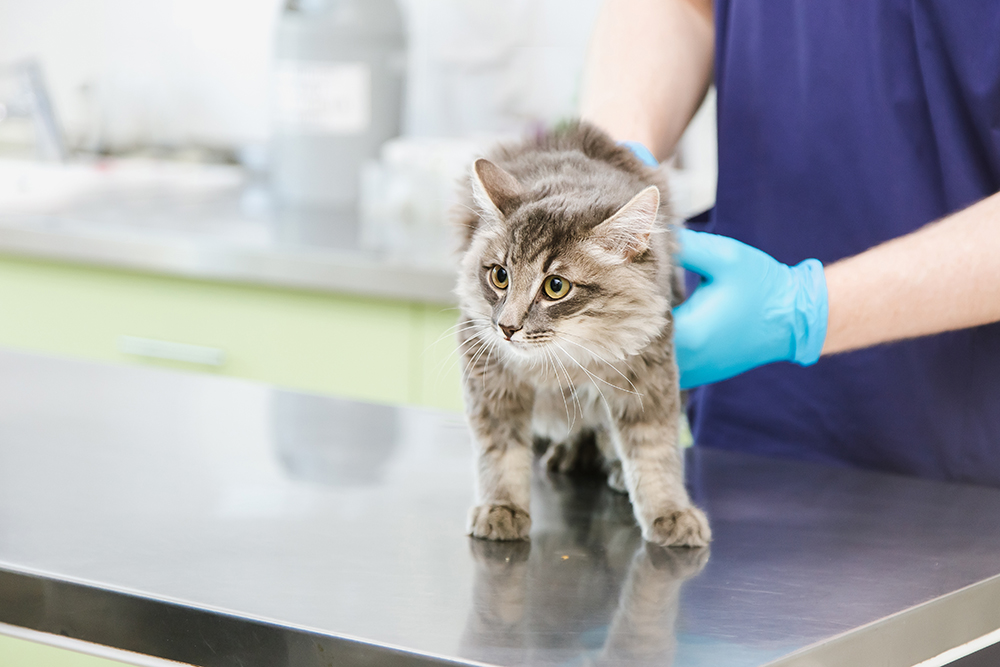

The 4 Types of Allergies in Cats
Allergies don’t necessarily come from one particular source. Your cat can be allergic to many potential allergens, so you should know the problem areas. Some cats will show signs of allergies throughout the whole year, while others may have periodic and only occasional issues, depending on the allergens in question and the season. Here are the most common.
1. Flea Allergy Dermatitis
Cats can develop allergies to flea bites and their saliva that causes irritation to the cat’s skin. This is the most common allergy in cats.
2. Atopic/Environmental Allergies
Cats can be allergic to many different kinds of mold and dust around the home. So, if your home is particularly dusty, you might need to upkeep it better to reduce signs of these types of allergies.
Believe it or not, cats, like us, can be allergic to pollen, trees, grass, and weeds, or a combination of them.
3. Food Allergies
Food allergies are considered a third most common allergy in cats. They can be allergic to any of the proteins used in their own diets, such as beef, pork, chicken, lamb, or others.
4. Contact Allergies
This is a rare condition in cats involving a local reaction when the skin is in contact with a certain shampoo, bedding, or collars.

What Is Hyposensitization and Why Is It Effective?
Hyposensitization treatment or immunotherapy can be a very effective method of easing signs of allergies in some cats. The process includes giving your cat a small quantity of triggering allergens through injections or oral medications. Depending on your cat’s specific allergy, they typically receive one injection or oral treatment once every 1 to 4 weeks.
The goal here is to build immune tolerance in the body. The general outcome of this treatment method is good, reducing signs of allergies in 60% to 80% of cats. Some cats take longer than others to show the benefit and others require lifelong therapy depending on the severity of the allergy.
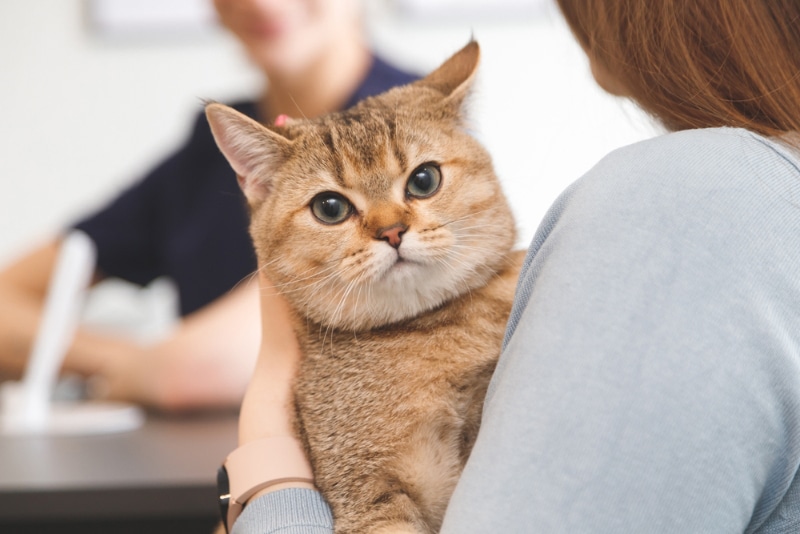

RAST vs. Intradermal Testing
Both types of testing have their pros and cons. Here’s a breakdown of each so you can get a better understanding of what to expect.
Intradermal Testing Pros & Cons
- Extremely accurate
- Considered gold standard by professionals
- Visual results
- Wide range of allergens tested
- Lengthy and costly test
- Requires sedative
- Requires specialized veterinary dermatologist
- Sometimes requires travel
- Cat must be shaved in an area of the skin where test is performed
RAST Pros & Cons
- Requires only a single blood sample
- Can be done at a traditional vet’s office
- Does not require sedation in most cases
- More affordable
- Notorious for false results when it comes to food allergies
- Less reliable than intradermal testing

Allergy Signs in Cats
Allergies can crop up for your cat at any time. The triggers can be innumerable. Allergy testing is so important because it can help in identifying what is bothering your cat. If you suspect your cat has allergies, speak to a veterinarian. But how exactly do you know when to take them in?
Manifestations of allergies include skin irritation, respiratory issues, and digestive system upset.
- Skin redness and irritation
- Hair loss
- Itching and scratching
- Coughing
- Sneezing
- Wheezing
- Nasal/eye discharge
- Vomiting
- Flatulence
- Diarrhea
If you suspect your cat has allergies, you should reach out to your veterinarian to make an appointment.
What Can Be Mistaken for Allergies?
Your pet should get hands-on care through this process. If your vet determines that they do not, in fact, have an allergy, they can do further testing to evaluate what might be triggering these similar signs.
Presence of skin parasites, such as fleas and mites, may also lead to excessive itching and scratching, which may be mistaken for allergies. Similar signs may occur with skin wounds, skin infections, abscesses, underlying systemic and organ disease, or auto-immune and other diseases.
Ongoing respiratory signs and discharge from the eyes and nose may also be a consequence of upper respiratory infections, such as viral cat flu, secondary bacterial infections, foreign bodies or polyps in the nose and back of the throat, pneumonia, or due to dental issues.
Chronic digestive signs, on the other hand, can occur with infectious gastroenteritis, pancreatitis, inflammatory bowel disease, organ system disease, or even cancer, depending on the cat’s age and presenting signs.


Frequently Asked Questions
How Much Does an Intradermal Test Cost?
This will greatly depend on the veterinary practice, and the cost of the test itself is also usually combined with a clinical examination, sedation protocol, consultation with a dermatologist, and other tests.
Generally, intradermal skin tests can cost anywhere from several hundred dollars to over $1,500, depending on the facility and the other previously mentioned factors. Your vet can provide you with an estimate in advance of the appointment. Keep in mind that follow-up appointments and ongoing treatments are required for cats with allergies, and the ongoing cost of managing this condition will be higher than the initial estimates.
How Much Does RAST Cost?
RAST tests at a vet’s office usually cost between $200 and $500, depending on the panel used, the number of allergens tested, the individual veterinary practice, and the cost of the consultation and additional tests.

How Effective Is Hyposensitization Therapy?
As we mentioned previously, hyposensitization therapies for cats to manage signs of allergies are roughly 60% to 80% effective. Some cats will need to have lifelong therapy in order to minimize the signs, and it may take around 12 months before any signs of improvement, while others only need treatment for a short while before improvements are visible.
There are also antihistamines and various immunosuppressants, such as corticosteroids and cyclosporin, that are commonly used for managing signs of allergies in cats, sometimes combined with antibiotics if there are signs of a skin infection.
How Much Does Allergy Treatment Cost?
Costs can really vary depending on the severity of your cat’s allergies. However, the average can even be as much as a few hundred dollars monthly, translated to several thousands annually. This cost can be much lower if you have a health insurance policy in place for your cat that was put into place before the issues first began.
What Are Alternatives to Treat Allergies?
Depending on the type of allergy your cat has, treatment can come with the elimination of specific triggers. For example, if your cat is allergic to pollen, grasses, and weeds, you can limit their access outside, but this effect is limited, as these allergens are inhalants and cannot be fully eliminated. Or, if your cat has some type of food allergy, you can give them a specialized diet that eliminates the triggering ingredient.


Importance of Insurance for Cats
Having a cat is a great responsibility that should not be taken lightly, and unfortunately, it can be quite costly, so it’s important to plan ahead in case of any health issues or accidents. Because the health and wellness of your cat is so crucial, we highly recommend pet insurance. The earlier you opt for pet insurance, the more issues will be covered.
If you opt for the health insurance of your choice, you can get everything that you want with a monthly premium that’s in your budget. That way, if your cat develops allergies anytime you have an active policy, the bulk of the cost will fall onto the insurance company once your deductible is paid. While not all policies cover allergies, you can get free quotes and explore coverage from many different companies on the market.
You can even bundle your cat’s insurance with your existing insurance company, providing they have the option to cover domestic pets. It’s certainly worth checking into and can foot a lot of the cost so you don’t have to.


Conclusion
If you feel your cat is suffering from allergies, the very first step you need to take is to contact your vet. Now that you’re familiar with the types of testing used to determine allergies, you can go in with an eased mind. For more accurate estimates and information, speak to your local veterinarian.
Plus, if finances are an issue, it’s nice to research how much these tests can cost so you can plan it for your budget. If you were just curious about allergies but your cat doesn’t seem to be displaying any signs, we encourage you to check out potential health insurance plans. It’s best to cover your cat before any health issues arise so you are able to afford the best treatment your cat needs.
Featured Image Credit: PRESSLAB, Shutterstock
